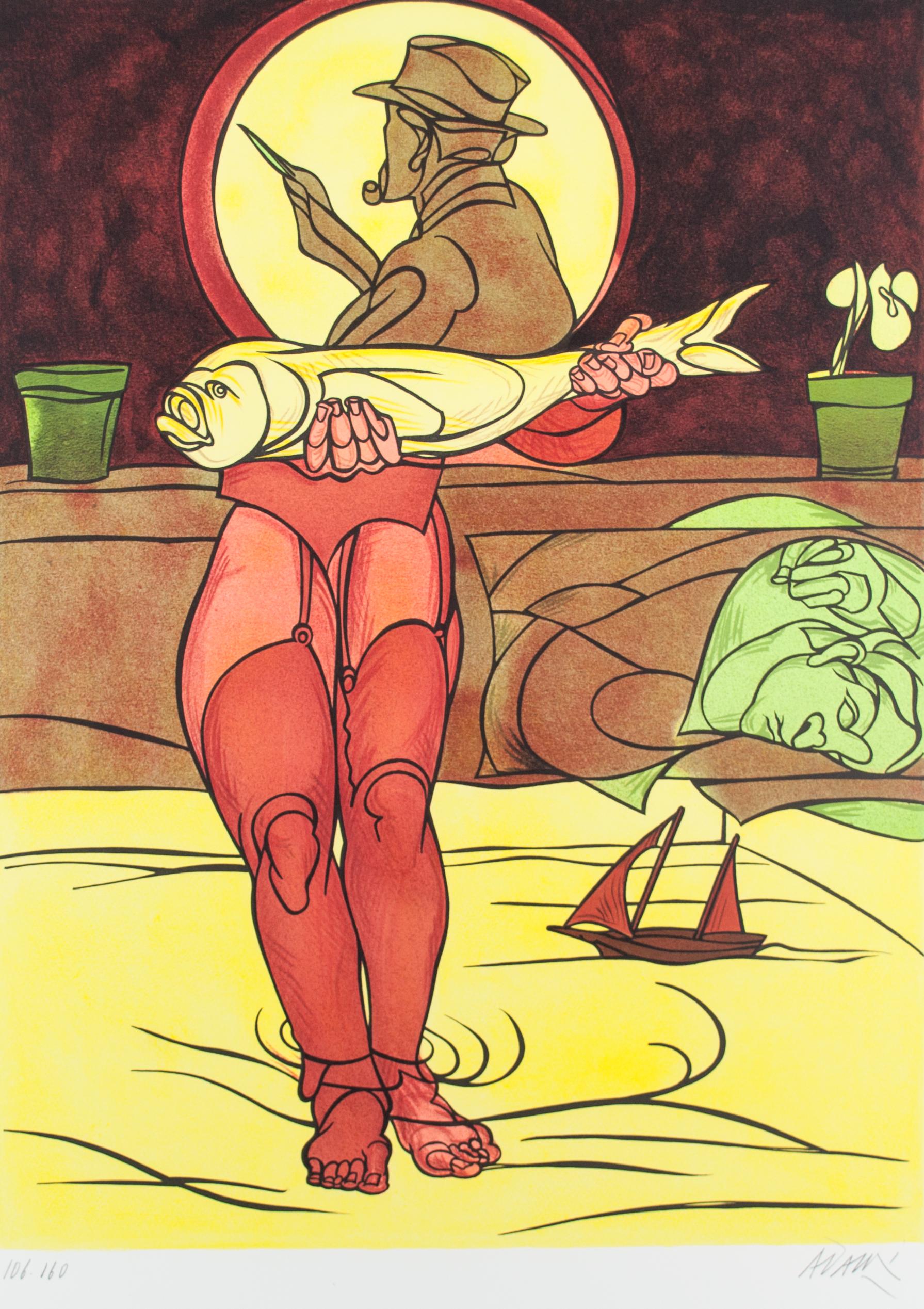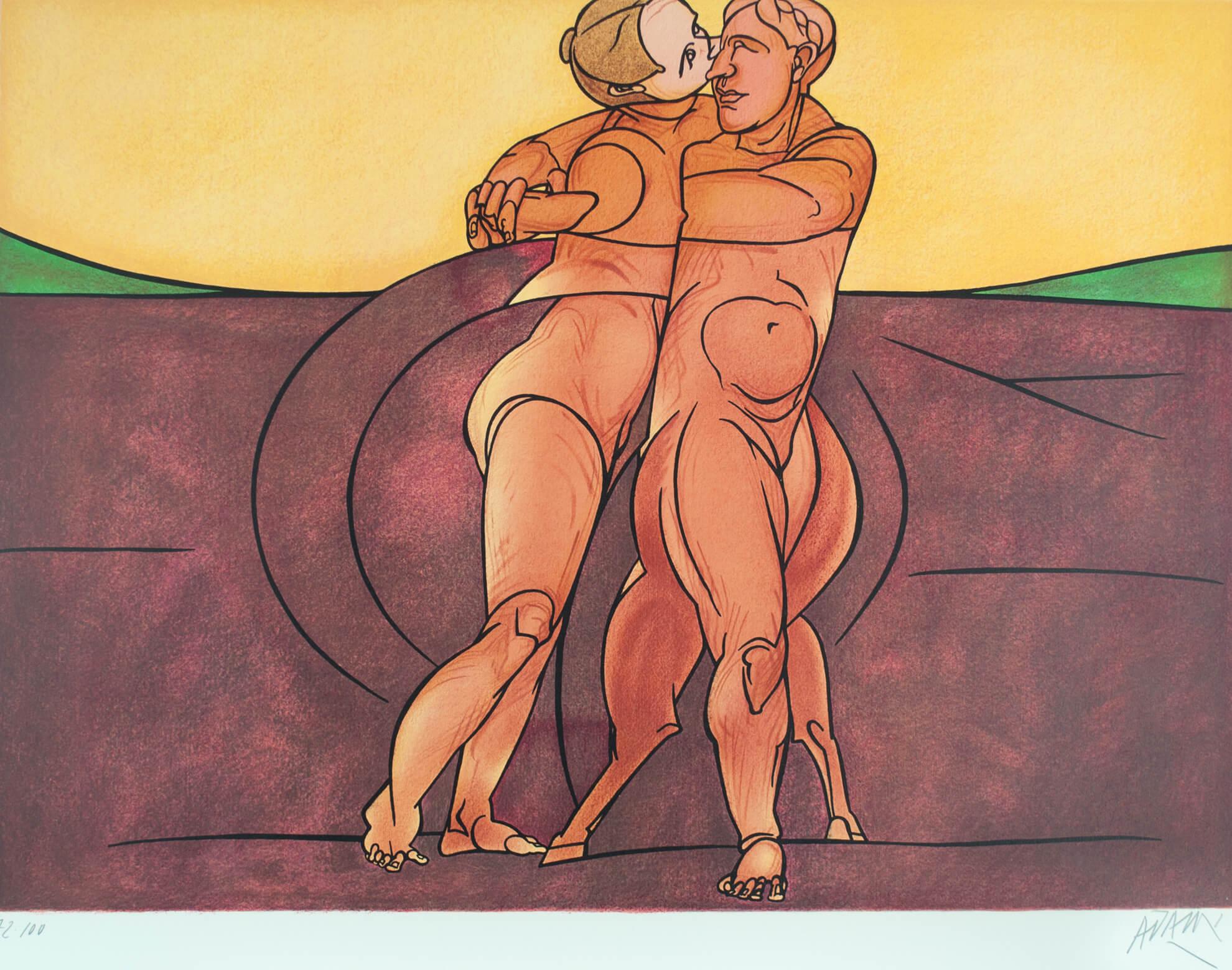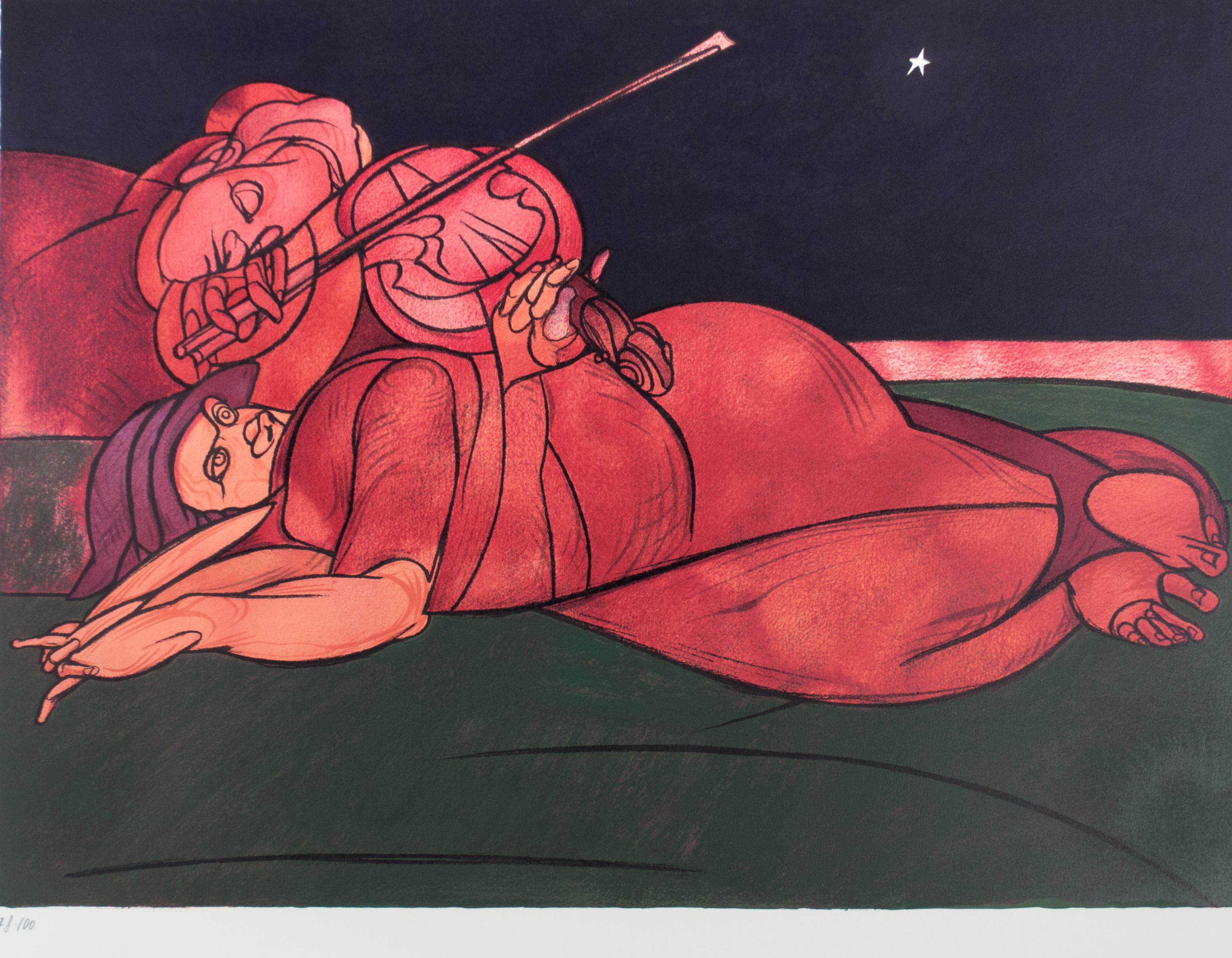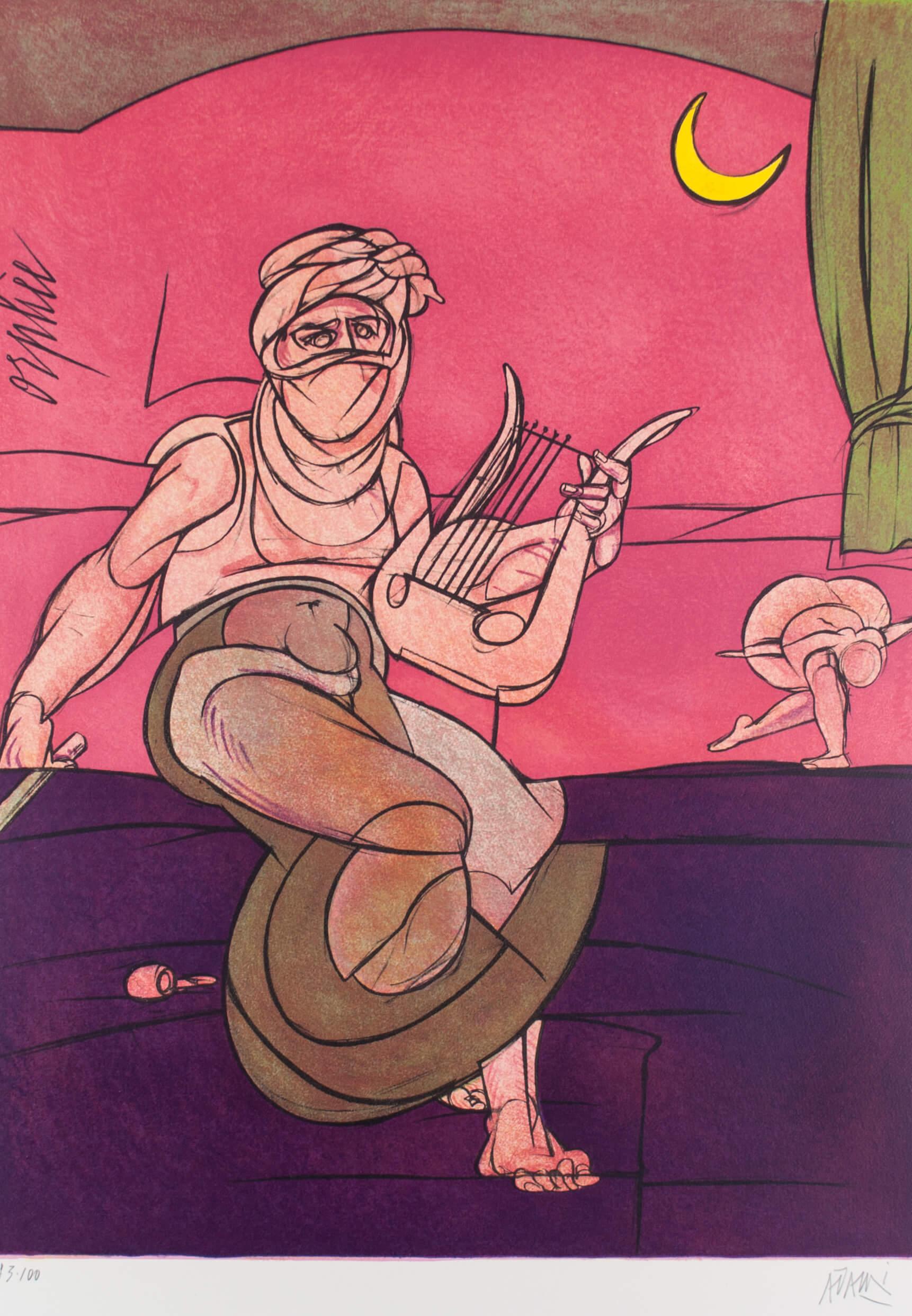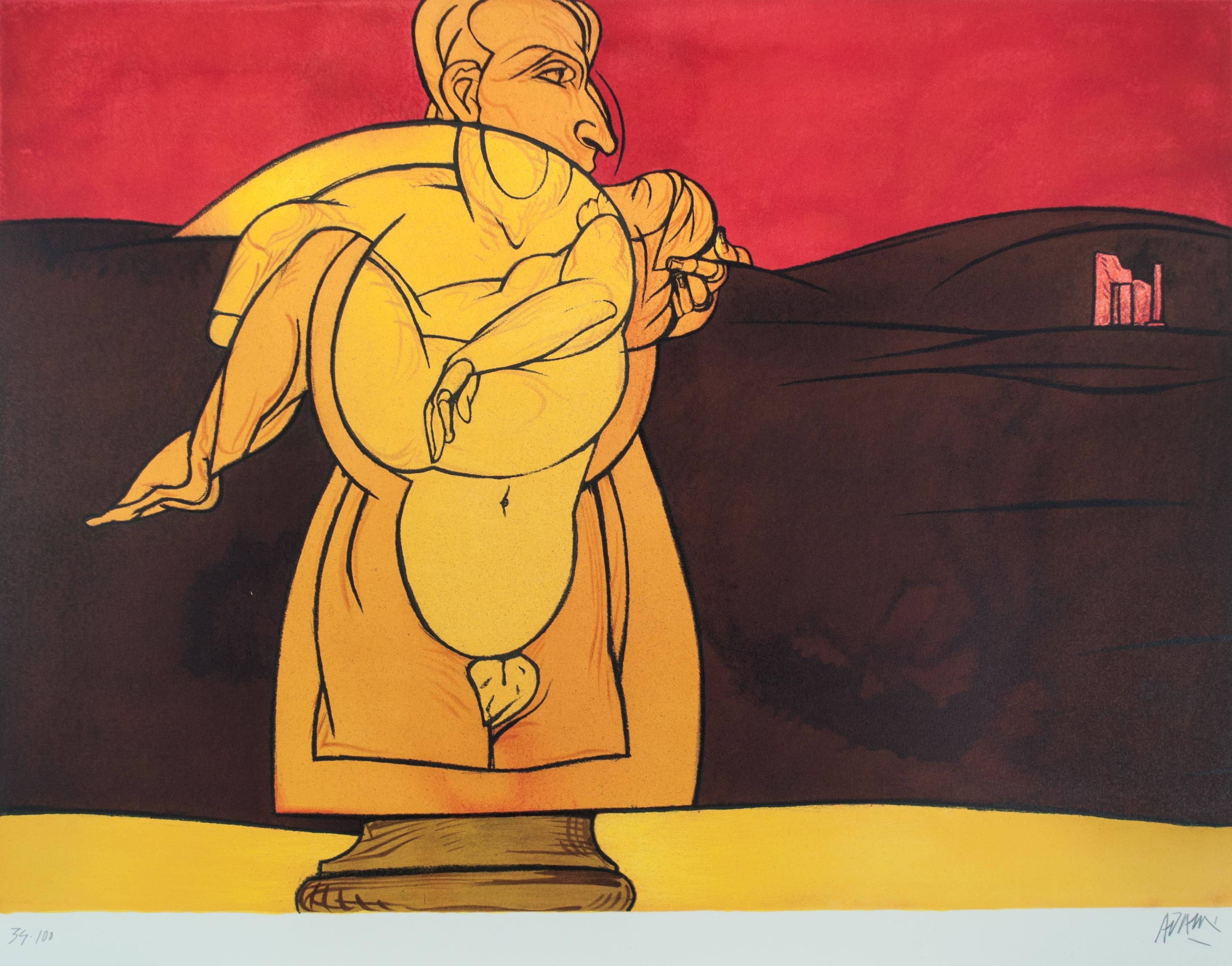Valerio AdamiLa Feuille de vigne1983
1983
About the Item
- Creator:Valerio Adami (1935, Italian)
- Creation Year:1983
- Dimensions:Height: 35.83 in (91 cm)Width: 25.99 in (66 cm)
- Medium:
- Movement & Style:
- Period:
- Condition:
- Gallery Location:Ljubljana, SI
- Reference Number:
Valerio Adami
Valerio Adami is an artist internationally recognized for his seductively rich and psychologically complex paintings. He started from an expressionist painting influenced by the work of Francis Bacon, and then he approached the abstract visual idioms of Pop Art with its cartoonish imagery, flatness and eye-popping colors. His artistic life was deeply marked by the meeting with the painters Roberto Sebastián Antonio Matta and Wilfredo Lam, who inspired and encouraged him to develop his talents. Adami’s works are layered with meanings, and his works are exhibited in the most important museums all over the world, London, New York, Venice, Chicago, Rome, Washington, Paris and Tokyo.
- ShippingRetrieving quote...Ships From: Ljubljana, Slovenia
- Return PolicyA return for this item may be initiated within 7 days of delivery.
- Jungle IBy Niki de Saint PhalleLocated in Ljubljana, SIJungle I. Original color litograph, unknown year. Niki de Saint Phalle was a French-American naive artist, a sculptor, painter and filmmaker, also known...Category
Late 20th Century Post-Modern Figurative Prints
MaterialsLithograph
- Il TondoBy Valerio AdamiLocated in Ljubljana, SIIl Tondo. Original color lithograph, 1984. Edition of 160 signed and numbered impressions on Arches paper. Valerio Adami is an Italian artist knows for his Nouvelle Figuration moveme...Category
1980s Post-Modern Figurative Prints
MaterialsLithograph
- MetamorphoseBy Valerio AdamiLocated in Ljubljana, SIMetamorphose. Original color litograph, 1982. Edition of 100 signed and numbered impressions on Arches paper. Published by Galerie Maeght, Paris. Valerio Adami is an Italian artist k...Category
1980s Post-Modern Figurative Prints
MaterialsLithograph
- L’étoile du matinBy Valerio AdamiLocated in Ljubljana, SIL’étoile du matin. Original color lithograph, 1983. Edition of 100 signed and numbered impressions on Arches paper. Valerio Adami is an Italian artist knows for his Nouvelle Figurati...Category
1980s Post-Modern Figurative Prints
MaterialsLithograph
- OrphéeBy Valerio AdamiLocated in Ljubljana, SIOrphée. Original color lithograph, 1985. Edition of 100 signed and numbered impressions on Arches paper. Published in Paris by Galerie Maeght-Lelong. Valerio Adami is an Italian arti...Category
1980s Post-Modern Figurative Prints
MaterialsLithograph
- Paysage de la reineBy Valerio AdamiLocated in Ljubljana, SIPaysage de la reine. Original color lithograph, 1985. Edition of 100 signed and numbered impressions on Arches paper. Valerio Adami is an Italian artist knows...Category
1980s Post-Modern Figurative Prints
MaterialsLithograph
- The Talmudists Post Soviet Non Conformist Avant Garde Judaica LithographBy Alek RapoportLocated in Surfside, FLDimensions w/Frame: 18.5 X 14.5 Alek Rapoport (November 24, 1933, Kharkiv, Ukraine SSR – February 4, 1997, San Francisco) was a Russian Nonconformist artist, art theorist and teacher. Alek Rapoport spent his childhood in Kiev (Ukraine SSR). During Stalin's "purges" both his parents were arrested. His father was shot and his mother spent ten years in a Siberian labor camp. Rapoport lived with his aunt. At the beginning of World War II, he was evacuated to the city of Ufa (the Bashkir Autonomous Soviet Socialist Republic). A time of extreme loneliness, cold, hunger and deprivation, this period also marked the beginning of Rapoport's drawing studies. After the war, Rapoport lived in Chernovtsy (Western Ukraine), a city with a certain European flair. At the local House of Folk Arts, he found his first art teacher, E.Sagaidachny (1886–1961), a former member of the nonconformist artist groups Union of the Youth (Soyuz Molodyozhi) and Donkey's Tail, popular during the 1910s–1920s. His other art teacher was I. Beklemisheva (1903–1988). Impressed by Rapoport's talent, she later (1950) organized his move to Leningrad, where he entered the famous V.Serov School of Art (the former School of the Imperial Society for the Promotion of Arts, OPKh, later the Tavricheskaya Art School). His association with this school lasted eight years, first as a student, and then, from 1965 to 1968, as a teacher. With "Socialist realism" the only official style during this time, most of the art school's faculty had to conceal any prior involvement in non-conformist art movements. Ya.K.Shablovsky, V.M.Sudakov, A.A.Gromov introduced their students to Constructivism only through clandestine means. (1959–1963) Rapoport studied stage design at the Leningrad Institute of Theater, Music and Cinema under the supervision of the famous artist and stage director N.P.Akimov. Akimov taught a unique course based on theories of Russian Suprematism and Constructivism, while encouraging his graduate students to apply their knowledge to every field of art design. Despite differences in personal artistic taste with Akimov, who was drawn to Vermeer and Dalí, Rapoport was influenced by Akimov's personality and liberalism, as well as the logical style of his art. In 1963, Rapoport graduated from the institute. His highly acclaimed MFA work involved the stage and costume design for I.Babel's play Sunset. In preparation, he traveled to the southwest regions of the Soviet Union, where he accumulated many objects of Judaic iconography from former ghettos, disappearing synagogues and old cemeteries. He wandered Odessa in search of Babel's characters and the atmosphere of his books. He organized a new liberal course in technical aesthetics, introducing his students to Lotman's theory of semiotics, the Modulor of Le Corbusier, the Bauhaus school, Russian Constructivism, Russian icons and contemporary Western art. As a result of his "radicalism," Rapoport was fired for "ideological conspiracy." He sought to cultivate himself as Jewish artist. This became particularly noticeable after the Six-Day War, when the Israeli victory led intellectuals, including the Jewish intelligentsia, to feel a heightened interest in Jewish culture and its Biblical roots. Rapoport's works of this period include Three Figures, a series of images of Talmudic Scholars, and works dealing with anti-Semitism. In the 1970s Rapoport joined the non-conformist movement, which opposed the dogmas of "Socialist realism" in art, along with Soviet censorship. The movement sought to preserve the traditions of Russian iconography...Category
1970s Post-Modern Figurative Prints
MaterialsLithograph
- The Rabbi 1977 Soviet Non Conformist Avant Garde PrintBy Alek RapoportLocated in Surfside, FLDimensions w/Frame: 25 3/4" x 20 3/4" Alek Rapoport (November 24, 1933, Kharkiv, Ukraine SSR – February 4, 1997, San Francisco) was a Russian Nonconformist artist, art theorist and teacher. Alek Rapoport spent his childhood in Kiev (Ukraine SSR). During Stalin's "purges" both his parents were arrested. His father was shot and his mother spent ten years in a Siberian labor camp. Rapoport lived with his aunt. At the beginning of World War II, he was evacuated to the city of Ufa (the Bashkir Autonomous Soviet Socialist Republic). A time of extreme loneliness, cold, hunger and deprivation, this period also marked the beginning of Rapoport's drawing studies. After the war, Rapoport lived in Chernovtsy (Western Ukraine), a city with a certain European flair. At the local House of Folk Arts, he found his first art teacher, E.Sagaidachny (1886–1961), a former member of the nonconformist artist groups Union of the Youth (Soyuz Molodyozhi) and Donkey's Tail, popular during the 1910s–1920s. His other art teacher was I. Beklemisheva (1903–1988). Impressed by Rapoport's talent, she later (1950) organized his move to Leningrad, where he entered the famous V.Serov School of Art (the former School of the Imperial Society for the Promotion of Arts, OPKh, later the Tavricheskaya Art School). His association with this school lasted eight years, first as a student, and then, from 1965 to 1968, as a teacher. With "Socialist realism" the only official style during this time, most of the art school's faculty had to conceal any prior involvement in non-conformist art movements. Ya.K.Shablovsky, V.M.Sudakov, A.A.Gromov introduced their students to Constructivism only through clandestine means. (1959–1963) Rapoport studied stage design at the Leningrad Institute of Theater, Music and Cinema under the supervision of the famous artist and stage director N.P.Akimov. Akimov taught a unique course based on theories of Russian Suprematism and Constructivism, while encouraging his graduate students to apply their knowledge to every field of art design. Despite differences in personal artistic taste with Akimov, who was drawn to Vermeer and Dalí, Rapoport was influenced by Akimov's personality and liberalism, as well as the logical style of his art. In 1963, Rapoport graduated from the institute. His highly acclaimed MFA work involved the stage and costume design for I.Babel's play Sunset. In preparation, he traveled to the southwest regions of the Soviet Union, where he accumulated many objects of Judaic iconography from former ghettos, disappearing synagogues and old cemeteries. He wandered Odessa in search of Babel's characters and the atmosphere of his books. He organized a new liberal course in technical aesthetics, introducing his students to Lotman's theory of semiotics, the Modulor of Le Corbusier, the Bauhaus school, Russian Constructivism, Russian icons and contemporary Western art. As a result of his "radicalism," Rapoport was fired for "ideological conspiracy." He sought to cultivate himself as Jewish artist. This became particularly noticeable after the Six-Day War, when the Israeli victory led intellectuals, including the Jewish intelligentsia, to feel a heightened interest in Jewish culture and its Biblical roots. Rapoport's works of this period include Three Figures, a series of images of Talmudic Scholars, and works dealing with anti-Semitism. In the 1970s Rapoport joined the non-conformist movement, which opposed the dogmas of "Socialist realism" in art, along with Soviet censorship. The movement sought to preserve the traditions of Russian iconography and the Constructivist/Suprematist style of the 1910s. Despite the authorities' persecutions of nonconformist artists (including arrests, forced evictions, terminations of employment, and various forms of routine hassling), they united in a group, "TEV – Fellowship of Experimental Exhibitions." TEV's exhibitions proved tremendously successful. In the same period, Rapoport became one of the initiators of another anti-establishment group, ALEF (Union of Leningrad's Jewish Artists). In the United States this group was known as "Twelve from the Soviet Underground." Rapoport's involvement with this group increased tension with the authorities and attracted KGB scrutiny, including "friendly conversations," surveillance, detentions and house arrests. It became increasingly dangerous for him to live and work in the USSR. In October 1976, Rapoport with his wife and son were forced to leave Russia. In Italy, Rapoport exhibited at the Venice Biennale, "La Nuova Arte Sovietica-Una prospettiva non-ufficiale" (1977), participated in television programs about nonconformist art in the Soviet Union, and created lithographic works continuing his theme of Jewish characters from Babel's play Sunset. In 1977, Rapoport's family was granted U.S. immigration status and settled in San Francisco. a significant event in Rapoport's life occurred in his meeting with San Francisco gallery owner Michael Dunev, who became his friend and representative, organizing all his exhibitions until the artist's death. Toward the end of the 1980s and beginning of the 1990s, Rapoport completed his most ambitious works on the theme of the Old Testament prophets: Samson Destroying the House of the Philistines (1989), Lamentation and Mourning and Woe (1990), the four paintings Angel and Prophets (1990–1991) and Three Deeds of Moses (1992). In 1992, the artist's friends in St. Petersburg organized the first exhibition of his works there since his departure into exile, with works patiently gathered from collectors and art museums. This exhibition, held in the City Museum of St. Petersburg and accompanied by headlines such as "A St. Petersburg artist returns to his town," was followed by much larger ones in 1993 (St. Petersburg and Moscow), organized in collaboration with Michael Dunev Gallery under the name California Branches – Russian Roots. He Exhibited in "Soviet Artists, Jewish Themes...Category
1970s Post-Modern Figurative Prints
MaterialsLithograph
- Desiree CalderonBy Agent XLocated in Kansas City, MOAgent X Title : Desiree Calderon Year: 2019 Medium: Digital Print Signed Edition: 125 70 x 70 inches Agent X, cultural explorer and agent of the unknown, is an emerging artist who c...Category
2010s Post-Modern Prints and Multiples
MaterialsLithograph, Offset
- Waile a Hawai 52 / 500 by Susan McGovney HansenLocated in Pasadena, CASusan McGovney Hansen 1933-2011 Lithograph in an edition limited to 500 signed and numbered prints. Signed in the Plate . Freelance pai...Category
1990s Post-Modern Figurative Prints
MaterialsLithograph
- BeachBy Marcia MarxLocated in Long Island City, NYArtist: Marcia Marx, American (1931 - 2005) Title: Beach Year: circa 1975 Medium: Lithograph, signed and numbered in pencil Edition: 250 Paper Size: 25 x 38 inchesCategory
Late 20th Century Post-Modern Figurative Prints
MaterialsLithograph
- 1978 Michael Knigin Manhattan Skyline PrintBy Michael KniginLocated in Larchmont, NYMichael Knigin (American, b. 1942) East Riverdance, 1978 Lithograph (?) Sight: 33 x 21 1/2 in. (image) Framed: 41 1/8 x 29 x 3/4 in. Signed, titled, dated, and numbered bottom Editio...Category
1970s Post-Modern Figurative Prints
MaterialsLithograph

